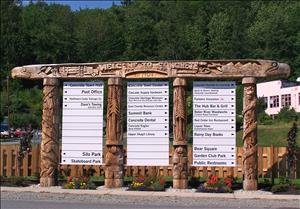In 1909, two small industrial communities merge to form the Town of Concrete, located in Skagit County near the confluence of the Baker and Skagit rivers. One community, called "Cement City" is located on the east bank of the Baker River around the Washington Portland Cement Company and the other is located on the west bank around the Superior Portland Cement Company. A few years later the two firms will also merge.
The town's economy -- manufacturing cement -- was based on a nearby limestone quarry as well as local clay deposits. Cement is made by mixing together and baking limestone and clay, then crushing it. It is the main ingredient of concrete (made essentially by adding crushed rock and water to cement).
Amasa Everett discovered the clay and limestone deposits that gave rise to the town. He brought samples to New York financiers who then formed the Washington Portland Cement Company in 1892. The firm built a processing plant on the east bank of the Baker, at the confluence of the two rivers. In 1898, the Superior Portland Cement Co. opened on the west bank.
A mile-long aerial tramway carried limestone to the processing plant, crossing town over Main Street and occasionally dropping chunks of its load on the heads of passersby. (Eventually the firm installed a safety net.) Many of the workers in the early days were Italian immigrants. They worked 12 hours a day, seven days a week.
Concrete originally had buildings made of wood. A series of fires on Main Street before 1921 persuaded the town to turn to concrete as its building material. The historic town now has many concrete buildings as well as a concrete bridge spanning the Baker River, the Henry Thompson Bridge, built 1916-1918 and now listed on the National Register of Historic Places.
In 1924, Puget Sound Power & Light built the Baker Dam northeast of Concrete to supply electricity to Bellingham. In 1968 the cement firm ceased operation. In 1972 the North Cascades Highway (State Route 20) was built through Concrete.
Concrete gained wider recognition when the writer Tobias Wolff, who attended Concrete High School, described life in the region in This Boy's Life. Wolff's memoir was made into a film (shot in Concrete) in 1993.

